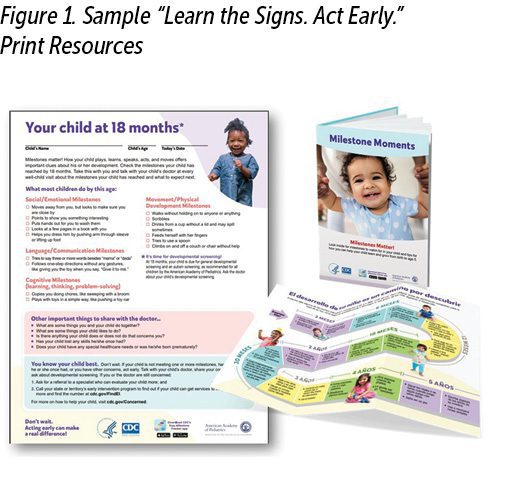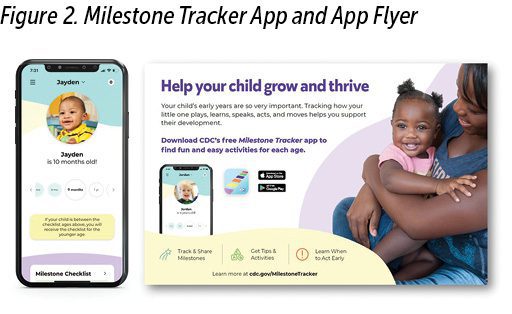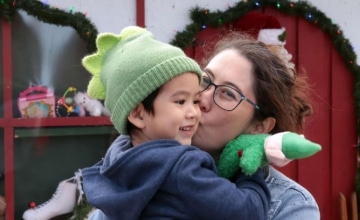Julia Abercrombie, Lisa Wiggins, and Katie K. Green, National Center on Birth Defects and Developmental Disabilities, Centers for Disease Control and Prevention, Atlanta, Georgia
Abstract
Approximately 1 in 6 children in the US has a developmental delay, disorder, or disability (DD). Early identification of DDs can help families access services that empower children and families, and it can improve child outcomes. The “Learn the Signs. Act Early.” (LTSAE) Program at the Centers for Disease Control and Prevention (CDC) encourages parents and providers to monitor every child’s early development and act when there is a concern. In February 2022, LTSAE released revised materials that include updated developmental milestone checklists to better support ongoing conversations between families and professionals. This article describes the purpose of the checklists and how early childhood professionals can use these free resources to engage families in developmental monitoring.
The most recent estimate from national survey data is that about 1 in 6 U.S. children 3–17 years old had a developmental delay, disorder, or disability (DD) during 2014–2018 (Cogswell et al., 2022). DDs can impact one or more areas of development, often co-occur, and may have lifelong consequences (Institute of Medicine (US) Committee on Nervous System Disorders in Developing Countries, 2001). Children with DDs have more health-related needs and service use and are 2–3 times more likely to live in households with high financial and psychological stress than children without DDs (Goudie et al., 2014).
Early Identification of Children With DDs
Early identification of children with DDs can lead to early intervention (Rotholz et al., 2017) that can improve developmental skills and intellectual functioning and empower families to advocate for services and help their child learn and grow (Estes et al., 2015; Hebbeler et al., 2007; Kasari et al., 2010; Noyes-Grosser et al., 2018). Some barriers to the early identification of children with DDs are infrequent contact with health care providers (e.g., lack of a medical home), insufficient routine developmental screening, lack of coordination between early childhood systems, and inconsistent referral practices and eligibility criteria (Twardzik et al., 2017). Another barrier to early identification is taking a “wait and see” approach where families and professionals continue to monitor concerns rather than addressing those concerns with developmental screening, evaluation, and/or supports (Raspa et al., 2015).
Developmental Milestones: Definition and Utility
Monitoring developmental milestones is useful in the early identification of children with DDs. Developmental milestones are skills that emerge over time and provide a foundation for more advanced skills to develop. A simple example is moving from the milestone of saying one word to combining two words together, and then talking in short sentences. Children are unique and develop skills at their own pace. However, developmental milestones tend to generally develop by a certain age and in a predictable sequence in most children living in the same cultural context—and can therefore be used as markers of typical development. When children are missing one or more milestones, it could be a sign of a developmental delay.
Learning about developmental milestones can empower families to better support their child’s developmental growth and, when needed, to advocate for additional services and support. It can be helpful for families to understand as early as possible that their child may be developing differently and may need additional supports. Such supports may be as simple as breaking directions down into smaller steps or providing extra time to do an activity, to more intensive services like speech, physical, or occupational therapies. Families who recognize their child may not be meeting milestones as expected or is behaving differently than other children can reject a “wait and see” approach and advocate for developmental screening and evaluation to determine need for additional supports. A deeper understanding of child development can also help prevent parents from second-guessing their parenting abilities or misinterpreting their child’s behaviors as “not listening” or purposely “being difficult.” Having knowledge about reasonable expectations for a child’s abilities at a specific age and understanding a child’s strengths, as well as areas in which they may need support, can empower families, support mental health, and protect against negative outcomes such as childhood abuse and neglect.
Family-Engaged Developmental Monitoring
Developmental monitoring is one part of developmental surveillance that the American Academy of Pediatrics (AAP) recommends at all well-child visits (health supervision visits) in order to identify children with DDs early (Lipkin et al., 2020). Family-engaged developmental monitoring involves sharing information, such as developmental milestone checklists, to promote knowledge of child development; talking with families about their child’s development; and asking if they have any concerns. Anyone can monitor a child’s development, including parents and other regular caregivers, educators, and other professionals. All early childhood professionals who engage families can help promote developmental monitoring and encourage families to learn about their child’s development, know what to expect, and discuss any questions or concerns they may have. Developmental monitoring does not require special training; it is an ongoing and informal process. Developmental monitoring can increase families’ knowledge and skills for promoting their child’s development and support them in understanding when to be concerned and when to share concerns with a provider (Graybill et al., 2016). Family-engaged developmental monitoring is therefore an important first step in the early identification of children who may be at risk for DD.
Developmental Screening
Developmental screening is another important part of the early identification process. Developmental screening is a formal comparison of a child’s development to other children the same age using standardized tools. Developmental screening can tell if a more in-depth evaluation of the child is warranted. If so, the next step is developmental evaluation to confirm if the child is experiencing a delay that could benefit from treatment. In the health care setting, AAP recommends that all children receive developmental screening at 9, 18, and 30 months old and screening specifically for autism spectrum disorder (ASD) at 18 and 24 months old, in addition to any time a concern is noted by a parent or other care provider (Lipkin et al., 2020).
Developmental monitoring and screening are complementary and often simultaneous processes. Both developmental monitoring and screening involve observing and/or identifying the progression of developmental milestones. During developmental monitoring, milestone checklists are often used to engage parents and better understand their concerns about child development. Screening also uses milestones, but the milestones used in screening tools have been studied against population norms to determine how timing of achievement is distributed in the general population. Another important difference between developmental monitoring and developmental screening is that developmental monitoring does not provide a score or a risk categorization for DDs whereas screening is designed for this purpose. It is important to understand the strengths and limitations of each process as well as the strengths and limitations of any tools being used to monitor or screen children’s development. Survey data have shown that children who received both developmental monitoring and screening together are more likely to receive early intervention than are children who received either monitoring or screening alone (Barger et al., 2018). However, in the 2016 National Survey of Children’s Health, only 19% of parents reported that their child received both developmental monitoring and screening in the health care setting (Hirai et al., 2018).
CDC’s “Learn the Signs. Act Early.” Program
Since 2004, CDC’s “Learn the Signs. Act Early.” (LTSAE) program has offered developmental milestone checklists and other free materials in multiple languages to help facilitate family-engaged developmental monitoring and acting early on developmental concerns. The program is funded by Congress to improve the early identification of children with DDs including ASD so children and families can get the services and supports they need. The program has three main components: (1) a health education campaign (see Figure 1), which includes milestone checklists, a Milestone Tracker app (see Figure 2), children’s books, trainings for early childhood professionals, and other resources; (2) an Act Early Initiative, which includes a network of 59 Act Early ambassadors in every state, Washington, DC, and 3 territories, who work to integrate developmental monitoring using LTSAE into state and local programs serving families with young children; and (3) research and evaluation projects to improve effectiveness of the program and better understand early identification of children with DDs.
Originally, the milestone checklists were developed as a family-friendly adaptation of milestones contained within two publications by the AAP to help support family-engaged developmental monitoring, Caring for Your Baby and Young Child: Birth to Age 5 (Shelov & Remer Altman, 2009) and Bright Futures: Guidelines for Health Supervision of Infants, Children, and Adolescents (Hagan et al., 2008). LTSAE materials are designed to be used by parents and families in addition to early childhood professionals. They are written between a 5th and 7th grade reading level in plain language. LTSAE aims to include milestones that are relatable to most families and observable in everyday settings as opposed to milestones measured in clinics and during testing of children. LTSAE milestones fit into the early identification process at the step of pre-contemplation of any developmental concerns as part of an awareness effort in the context of health communications. LTSAE milestone checklists are not “guidelines” nor “standards” for child development, nor are they to be used as a developmental screening tool. Instead, the milestone checklists were developed to promote developmental monitoring and encourage conversations between parents, health care providers, and early childhood providers about child development.
Evaluation of the program has found that LTSAE milestone checklists teach parents and professionals about skills children would be expected to develop by a certain age and empower families to take a more active role in their child’s care by initiating conversations with providers and asking for screening or evaluation when concerned. Families are the experts on their child, and tools such as CDC milestone checklists can help families and professionals work together to monitor and promote their child’s development (Gadomski et al., 2018; Graybill et al., 2016; Raspa et al., 2015).
Developmental Milestone Checklist Revisions
In February 2022, LTSAE released revised developmental milestone checklists. The LTSAE milestone materials were revised for three main reasons. First, CDC wanted to be able to offer a LTSAE checklist for every age at which there is an AAP recommended health supervision visit between 2 months and 5 years old to best facilitate conversations between parents and care providers at each of those visits. CDC therefore needed to add 15- and 30-month checklists. Second, CDC wanted to assign milestones to ages when most children (i.e., about 75% or more) would be expected to exhibit them, to promote discussion and action when a milestone is missed (rather than taking a “wait and see” approach that may be appropriate for median age milestones because half of children wouldn’t yet be expected to have achieved them). Third, parents and early childhood professionals had provided feedback over the years on how to improve milestone checklists. One suggestion was to remove similar milestones from multiple age-specific checklists. Another suggestion was to show how achievement of early milestones can lead to skill advancement. LTSAE therefore removed duplicate milestones and made sure that milestones showed a progression of skill development across ages.
There was also confusion about what milestones were most important on the checklists and when a missed milestone should prompt conversation between families and professionals. The previous checklists had two lists of milestones: a general list of milestones and an “Act early…Don’t wait” call-out box encouraging further action. This format created confusion on whether missing milestones in the general list and/or the “act early” list were concerning, and professionals questioned “which ones and how many can you miss?” Users also reported that the old checklists were creating unnecessary worry because parents were encouraged to “act early” and talk with their health care provider if their child missed a milestone, but some of the milestones were placed at the median age of achievement, such that only half of children would be expected to achieve it by a specific age. As a public health program providing a health communication tool, it is important to provide information that is clear and as evidence-informed as possible, in order to increase awareness without causing unnecessary concerns. The approach of providing milestones that most children would be expected to achieve may help prevent unnecessary worry or uncertainty about appropriate next steps.

Learning about developmental milestones can empower families to better support their child’s developmental growth and, when needed, to advocate for additional services and support.
The revision process was a joint effort of the AAP and CDC’s LTSAE program, supported by an existing cooperative agreement. For transparency and to share the evidence for each milestone, the changes to the LTSAE milestone materials were released in conjunction with a peer-reviewed article in the journal Pediatrics detailing the revision process and all the sources of data consulted (Zubler et al., 2022). A literature review informed the placement of the developmental milestones included on the milestone checklists. That evidence, along with their expert clinical judgement, helped guide the authors in deciding at which well-child visit age to place the evidence-informed milestones. The review of evidence and revisions were completed in 2019, and parent testing for understanding and relatability was done in the summer of 2020.
One conclusion of the published article was that normative data for developmental milestones are lacking, meaning that there is little available evidence on when specific developmental milestones are attained by a certain percentage of the population. A systematic literature review found only 34 articles and, of those, 24 had the type of normative data that indicated what a certain percent of children were expected to do by a certain age. Social–emotional and cognitive milestones were the most difficult to find. Even still, the authors were able to match 80% of the new milestones to normative data from at least one source. The information from this review can inform future research needs. Research on social–emotional and cognitive milestones is especially important because these milestones are least represented in the current literature.
Important Considerations About the Revisions
As previously noted, the LTSAE milestone checklists are health communication tools intended to engage families and support conversations about children’s development during health supervision visits; parent–teacher conferences; Special Supplemental Nutrition for Women, Infants, and Children (WIC) visits; and other types of opportunities to engage families about child development. One goal of the LTSAE milestone checklists is to educate and engage families and other early care providers about some skills and abilities most children would be expected to do by specific ages. Revisions to the milestone checklists aim to remove any confusion as to whether a conversation between a parent and professional should occur if a milestone has not been achieved. The new set of milestones represent what at least 75% of children can do at a specific age to better identify potential concerns. If a milestone has not been mastered, a conversation is warranted.
There are expanded tips and activities for supporting children’s development on the revised LTSAE materials, and relational health and additional open-ended questions to help facilitate conversations between parents, health care providers, and others. The checklists and other LTSAE materials also inform parents of when routine developmental screening is due, and they support families in discussing concerns and asking about screening and other assessments if they have concerns. The milestone checklists also provide parents with information on how to access early intervention programs in their state, including information that they can self-refer for evaluation for early intervention services.
It is important to note that the milestones do not replace or change screening or diagnostic evaluation tools used by therapists or other specialists or the development of their treatment plans and should not be used to establish medical necessity for initiation or as justification for the discontinuation of services. The checklists also do not contain all possible milestones children might exhibit. Inclusion or exclusion of a milestone was based on limited available published evidence and is not a reflection of the significance of a particular milestone in a child’s development.
To summarize, the revised developmental milestones clarify when to act early in an effort to decrease a “wait and see” approach using plain language and family-friendly materials. There are now open-ended questions that may lead to improved sharing of concerns even when there is no corresponding milestone. Further, the additional tips and activities can strengthen developmental promotion. It is important to remember that these milestone checklists are not developmental screeners or “pre-screeners,” nor assessment tools.
They are not inclusive of all potential milestones. As these resources are new, they have not yet been evaluated in practice to assess if and how they improve conversations and support developmental surveillance and developmental screening.
Promising Practices for Using LTSAE Resources
Following are suggestions for how families, early childhood professionals, and health care providers can best use the LTSAE materials.
Families
The LTSAE resources are designed primarily for families so they can celebrate their child’s progress by tracking their developmental milestones. Families are encouraged to share that progress with their child’s doctor at every check-up and with other early childhood professionals. The LTSAE materials encourage parents and caregivers not to wait if they have concerns about development. Families know their child best. If a child is not meeting even one milestone on the checklist or has lost a skill, or if the family has other concerns, they can act early by talking with their child’s doctor or other early childhood provider and ask about developmental screening. If there are continued concerns, they can also reach out to their state or territory’s early intervention program for evaluation.
Early Childhood Professionals
Early childhood professionals such as early childhood education providers, WIC staff, home visitors, and others who work with young children can use LTSAE materials to engage families in developmental monitoring. For instance, WIC programs in some states are participating in a project with the Association of State Public Health Nutritionists to promote the Developmental Milestone Checklist Program for WIC program staff. This program was developed with Missouri WIC staff and tested in Missouri WIC clinics. It consists of (1) placing engaging graphics on the walls and floors of WIC clinics to introduce milestones in a fun and friendly way, (2) inviting parents to complete a milestone checklist during certification and mid-certification visits or whenever there is a question or concern about development, and (3) making a referral if there are any missing milestones or concerns noted (CDC, 2022a). In an evaluation of the program in Missouri, most WIC staff who were surveyed (≥ 80%) reported that checklists fit easily into clinic workflow and required ≤ 5 minutes to complete. In addition, ≥ 90% reported referring one or more children with potential developmental concerns (Farmer et al., 2022).
Home visiting programs can use the LTSAE resources to supplement their curriculum as additional parent engagement materials that complement developmental screening taking place in many programs, as can early childhood education providers, including Head Start. Early childhood education professionals can also take advantage of free continuing education credit offered through the CDC’s (2021) Watch Me! Celebrating Milestones and Sharing Concerns online training (Abercrombie et al., 2021; Chödrön et al., 2021).

Anyone can monitor a child’s development, including parents and other regular caregivers, educators, and other professionals.
Early intervention programs can use the LTSAE materials to enhance their Child Find campaigns to raise public awareness of the benefits of early intervention and help guide parents on steps to take when there is a concern about a child’s development. The materials can be customized with local early intervention referral contact information. LTSAE resources can also support child welfare professionals and prevention partners, who often work with highly vulnerable children and youth who may be at risk of DDs or in early identification, assist with required referrals, and promote protective factors (CANTASD, n.d.).
Health Care Providers
LTSAE continues to provide training and resources for health care providers to improve developmental monitoring and screening and increase their awareness of the LTSAE milestone checklists (CDC, 2022b). The program’s free resources help health care providers obtain Continuous Medical Education and Maintenance of Certification and implement Quality Improvement projects in health care settings. These trainings are especially important for providers to take or re-take to ensure awareness that the revised milestones include those that most (about 75% or more) children would be expected to have achieved and that action is warranted if a child is missing a milestone.
Initiatives to Improve Early Identification of DDs
Strong partnerships and collaboration are important to improve early identification. Recognizing this, LTSAE launched the Act Early ambassadors as a pilot project in 2011 to support states’ work toward improving early identification of DDs. Ambassadors are professionals with medical, child development, developmental disability, special education, or early intervention expertise who were selected to (1) serve as a state or territorial point-of-contact for the national LTSAE program; (2) support the work of state/territorial or national initiatives to improve early identification of DDs; and (3) promote the adoption and integration of LTSAE resources into systems that serve young children and their families (CDC, 2022c). The Act Early ambassador program has grown to a robust network of 59 ambassadors representing all 50 states, Washington, DC, and 3 territories.

The milestone checklists were developed to promote developmental monitoring and encourage conversations between parents, health care providers, and early childhood providers about child development.
In 2020, CDC was able to leverage the Act Early ambassador network to fund 43 State and Territorial Act Early COVID-19 Response Teams with a 2-year grant opportunity to support families and systems affected by the COVID-19 pandemic. This initiative focused on support for early childhood state systems in lessening the negative effects of the COVID-19 pandemic on the early identification of DDs and strengthening resilience skills, behaviors, and resources of children, families, and communities. During year one of the project, teams worked to bolster and evaluate activities to improve early identification of children with DDs from birth to 5 years old during the COVID-19 pandemic; and to advance the promotion and distribution of relevant, existing tools, materials, and programs to improve resiliency among families with young children. During year two of the project, 41 teams worked to (1) maintain an ambassador-led state/territory team that included key early childhood partners; (2) develop, implement, and evaluate a plan to improve early identification of DDs that addresses important components or steps of early identification (developmental monitoring, developmental screening, referral, and receipt of services) and supports families in transitioning from step to step to reduce loss to follow up; and, (3) promote resiliency skills and behaviors among children, families, providers, and/or early childhood systems.
Through both Act Early ambassadors and Act Early Response to COVID efforts important partnerships were formed with other initiatives that include a focus on early identification of children with DDs. These partnerships have included Help Me Grow programs, which are working toward effective, universal, early childhood systems, ensuring developmental promotion for all children, and early detection, referral, and connection to services when needed. Partnerships were also formed with Early Childhood Comprehensive Systems projects funded by the Health Resources and Services Administration that strengthen state-level leadership, coordination, and strategic improvements in early childhood systems (HRSA Maternal & Child Health, 2022).
Conclusion
LTSAE and many other initiatives and early childhood professionals share the common goal of identifying DDs as early as possible to help families access services that can lead to improved outcomes. The LTSAE program supports child development and the early identification of developmental concerns through free materials, partnerships, and Act Early initiatives. LTSAE developmental milestone checklists are not screening tools and should not replace developmental screening, nor are they guidelines or standards for development. Revisions to ensure milestones included are those that most (as opposed to half of) children would be expected to achieve by given ages are intended to reduce unnecessary worry and discourage a “wait and see” approach. The LTSAE milestone checklists are designed to support ongoing conversations as a part of family-engaged developmental monitoring. Developmental monitoring, surveillance, and screening are complementary but different processes that are each part of a layered and continuous approach to early identification of children with DDs across systems. Knowing the strengths and limitations of the tools and processes that support each of these processes is important when considering next steps.
Authors’ Note
The findings and conclusions in this report are those of the authors and do not necessarily represent the official position of the Centers for Disease Control and Prevention.
Correspondence regarding this article should be addressed to Julia Abercrombie, [email protected].
Authors
Julia Abercrombie, MPH, is a behavioral scientist for the Centers for Disease Control and Prevention’s “Learn the Signs. Act Early.” program within the National Center on Birth Defects and Developmental Disabilities (NCBDDD). She joined NCBDDD in 2009 and has supported public health surveillance and research on developmental disabilities and partnership and policy efforts to improve the health of people with and at risk for disabilities. Ms. Abercrombie earned a bachelor’s degree in psychology from Emory University and was awarded her master’s in public health in behavioral science and health education from the Rollins School of Public Health, Emory University.
Lisa Wiggins, PhD, is a behavioral scientist with the National Center on Birth Defects and Developmental Disabilities at the Centers for Disease Control and Prevention in Atlanta, GA. In that role, she designs and implements public health projects that improve the lives of children with developmental disabilities and their families. Dr. Wiggins is a leading expert on autism spectrum disorder (ASD) and provides consultation for national and international projects related to screening, assessing, diagnosing, and helping individuals with ASD throughout the lifespan. She has more than 20 years of experience with psychological assessment and has authored more than 100 publications and presentations. Dr. Wiggins has a master of science degree in applied clinical psychology from Augusta University and a master of arts and a doctorate in developmental psychology from Georgia State University.
Katie K. Green, MPH, is a health communication specialist and team lead with the National Center on Birth Defects and Developmental Disabilities’ “Learn the Signs. Act Early.” program at the Centers for Disease Control and Prevention (CDC) in Atlanta, GA. CDC’s “Learn the Signs. Act Early.” program is a national program to improve early identification of children with autism and other developmental disabilities. Ms. Green’s work focuses predominantly on the research, development, and dissemination of informational tools and resources to help parents learn about development milestones, early warning signs of developmental delay, and the importance of acting early on developmental concerns. Ms. Green received a bachelor of science degree in biobehavioral health from Pennsylvania State University and a master of public health degree from Georgia State University.
Suggested Citation
Abercrombie, J., Wiggins, L., & Green, K. (2022). CDC’s “Learn the Signs. Act Early.”: Developmental milestone resources to improve early identification of children with developmental delays, disorders, and disabilities. ZERO TO THREE Journal, 43(1), 5–12.
References
Abercrombie, J., Pann, J., Shin, F., Taylor, E., Brisendine, A. E., Swanson-Holm, R., James, C., Viehweg, S., & Chödrön, G. (2021). Evaluation of the feasibility and perceived value of integrating Learn the Signs. Act Early. developmental monitoring resources in Early Head Start. Early Childhood Education Journal. https://doi.org/10.1007/s10643-021-01247-5 https://link.springer.com/article/10.1007/s10643-021-01247-5
Barger, B., Rice, C., Wolf, R., & Roach, A. (2018). Better together: Developmental screening and monitoring best identify children who need early intervention. Disability and Health Journal, 11(3), 420–426. https://doi.org/10.1016/j.dhjo.2018.01.002. www.sciencedirect.com/science/article/abs/pii/S1936657418300037?via%3Dihub
CANTASD. (n.d.). Identifying developmental disabilities and delays in young children: The role of child welfare professionals and partners. https://cblcc.acf.hhs.gov/wp-content/uploads/CDC-Learn-Signs_508.pdf
Centers for Disease Control and Prevention. (2021). Watch me! Celebrating milestones and sharing concerns. www.cdc.gov/WatchMeTraining
Centers for Disease Control and Prevention. (2022a). Developmental Milestone Checklist program for WIC program staff. www.cdc.gov/ncbddd/wicguide/index.html
Centers for Disease Control and Prevention. (2022b). Developmental surveillance resources for healthcare providers. www.cdc.gov/ActEarly/healthcare
Centers for Disease Control and Prevention. (2022c). Find your Act Early ambassador. www.cdc.gov/ActEarly/Ambassadors
Chödrön, G., Pizur-Barnekow, K., Viehweg, S., Puk-Ament, A., & Barger, B. (2021). Childcare providers’ attitudes, knowledge, and practice related to developmental monitoring to promote early identification and referral. Early Child Development and Care, 191(4), 520–534. https://doi.org/10.1080/03004430.2019.1626373. www.tandfonline.com/doi/full/10.1080/03004430.2019.1626373?cookieSet=1
Cogswell, M. E., Coil, E., Tian, L. H., Tinker, S. C., Ryerson, A. B., Maenner, M. J., Rice, C. E., & Peacock, G. (2022). Health needs and use of services among children with developmental disabilities—United States, 2014–2018. Morbidity and Mortality Weekly Report, 71(12), 453–458. https://doi.org/10.15585/mmwr.mm7112a3. www.cdc.gov/mmwr/volumes/71/wr/mm7112a3.htm?s_cid=mm7112a3_w
Estes, A., Munson, J., Rogers, S. J., Greenson, J., Winter, J., & Dawson, G. (2015). Long-term outcomes of early intervention in 6-year-old children with autism spectrum disorder. Journal of the American Academy of Child & Adolescent Psychiatry, 54(7), 580–587. https://doi.org/10.1016/j.jaac.2015.04.005. https://www.jaacap.org/article/S0890-8567(15)00256-7/fulltext
Farmer, J. E., Falk, L. W., Clark, M. J., Mayfield, W. A., & Green, K. K. (2022). Developmental monitoring and referral for low-income children served by WIC: Program development and implementation outcomes. Maternal and Child Health Journal, 26(2), 230–241. https://doi.org/10.1007/s10995-021-03319-9. https://link.springer.com/article/10.1007/s10995-021-03319-9
Gadomski, A. M., Riley, M. R., Scribani, M., & Tallman, N. (2018). Impact of “Learn the Signs. Act Early.” materials on parental engagement and doctor interaction regarding child development. Journal of Developmental & Behavioral Pediatrics, 39(9), 693–700. https://doi.org/10.1097/dbp.0000000000000604. https://journals.lww.com/jrnldbp/Abstract/2018/12000/ Impact_of__Learn_the_Signs__Act_Early___Materials.3.aspx
Goudie, A., Narcisse, M. R., Hall, D. E., & Kuo, D. Z. (2014). Financial and psychological stressors associated with caring for children with disability. Families, Systems, & Health, 32(3), 280–290. https://doi.org/10.1037/fsh0000027. https://doi.apa.org/record/2014-12179-001?doi=1
Graybill, E., Self-Brown, S., Lai, B., Vinoski, E., McGill, T., & Crimmins, D. (2016). Addressing disparities in parent education: Examining the effects of Learn the Signs/Act Early parent education materials on parent outcomes. Early Childhood Education Journal, 44(1), 31–38. https://doi.org/10.1007/s10643- 014-0680-3. https://link.springer.com/article/10.1007/s10643-014-0680-3
Hagan, J., Shaw, J. S., & Duncan, P. M., (Ed.). (2008). Bright Futures: Guidelines for health supervision of infants, children, and adolescents (3rd ed.). American Academy of Pediatrics.
Hebbeler, K., Spiker, D., Bailey, D., Scarborough, A. A., Mallik, S., Simeonsson, R. J., Singer, M., & Nelson, L. (2007). Early intervention for infants and toddlers with disabilities and their families: Participants, services, and outcomes. SRI International. www.sri.com/publication/education-learning-pubs/early-learning-pubs/national-early-intervention-longitudinal-study-neils-final-report
Hirai, A. H., Kogan, M. D., Kandasamy, V., Reuland, C., & Bethell, C. (2018). Prevalence and variation of developmental screening and surveillance in early childhood. JAMA Pediatrics, 172(9), 857–866. https://doi.org/10.1001/jamapediatrics.2018.1524. https://jamanetwork.com/journals/jamapediatrics/fullarticle/2686728
HRSA Maternal & Child Health. (2022). Early childhood systems. https://mchb.hrsa.gov/programs-impact/early-childhood-systems
Institute of Medicine (US) Committee on Nervous System Disorders in Developing Countries. (2001). Developmental disabilities. In Neurological, psychiatric, and developmental disorders: Meeting the challenge in the developing world. National Academies Press (US). www.ncbi.nlm.nih.gov/books/NBK223473
Kasari, C., Gulsrud, A. C., Wong, C., Kwon, S., & Locke, J. (2010). Randomized controlled caregiver mediated joint engagement intervention for toddlers with autism. Journal of Autism and Developmental Disorders, 40(9), 1045– 1056. https://doi.org/10.1007/s10803-010-0955-5. https://link.springer.com/article/10.1007/s10803-010-0955-5
Lipkin, P. H., Macias, M. M., Council on Children With Disabilities, Section on Developmental and Behavioral Pediatrics, Norwood, K. W., Jr., Brei, T. J., Davidson, L. F., Davis, B. E., Ellerbeck, K. A.,…Voigt, R. G. (2020). Promoting optimal development: Identifying infants and young children with developmental disorders through developmental surveillance and screening. Pediatrics, 145(1). https://doi.org/10.1542/peds.2019-3449. https://publications.aap.org/pediatrics/article/145/1/e20193449/36971/Promoting-Optimal-Development-Identifying-Infants?autologincheck=redirected
Noyes-Grosser, D. M., Elbaum, B. E., Wu, Y., Siegenthaler, K., Cavalari, R. N. S., Gillis, J. M., & Romanczyk, R. G. (2018). Early intervention outcomes for toddlers with autism spectrum disorder and their families. Infants & Young Children, 31, 177–199.
Raspa, M., Levis, D. M., Kish-Doto, J., Wallace, I., Rice, C., Barger, B., Green, K. K., & Wolf, R. B. (2015). Examining parents’ experiences and information needs regarding early identification of developmental delays: Qualitative research to inform a public health campaign. Journal of Developmental & Behavioral Pediatrics, 36(8). https://journals.lww.com/jrnldbp/Fulltext/2015/10000/Examining_Parents__Experiences_and_Information.4.aspx
Rotholz, D., Kinsman, A., Lacy, K., & Charles, J. (2017). Improving early identification and intervention for children at risk for autism spectrum disorder. Pediatrics, 139. https://doi.org/10.1542/peds.2016-1061. https://publications.aap.org/pediatrics/article-abstract/139/2/e20161061/60117/Improving-Early-Identification-and-Intervention?redirectedFrom=fulltext
Shelov, S. P., & Remer Altman, T. (Eds.). (2009). Caring for your baby and young child: Birth to age 5 (5th ed.). American Academy of Pediatrics.
Twardzik, E., Cotto-Negrón, C., & MacDonald, M. (2017). Factors related to early intervention Part C enrollment: A systematic review. Disability and Health Journal, 10(4), 467–474. https://doi.org/10.1016/j.dhjo.2017.01.009. www.sciencedirect.com/science/article/abs/pii/S1936657417300110
Zubler, J. M., Wiggins, L. D., Macias, M. M., Whitaker, T. M., Shaw, J. S., Squires, J. K., Pajek, J. A., Wolf, R. B., Slaughter, K. S., Broughton, A. S., Gerndt, K. L., Mlodoch, B. J., & Lipkin, P. H. (2022). Evidence-informed milestones for developmental surveillance tools. Pediatrics, 149(3). https://doi.org/10.1542/peds.2021-052138. https://publications.aap.org/pediatrics/article/149/3/e2021052138/184748/Evidence-Informed-Milestones-for-Developmental






